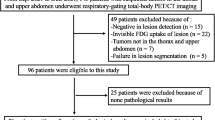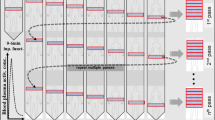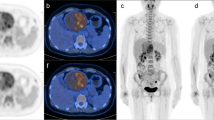Abstract.
Fusion of morphology and function has been shown to improve diagnostic accuracy in many clinical circumstances. Taking this into account, a number of instruments combining computed tomography (CT) with positron emission tomography (PET) or single-photon emission tomography (SPET) are appearing on the market. The aim of this study was to evaluate a simple and cost-effective approach to generate fusion images of similar quality. For the evaluation of the proposed approach, patients with neuroendocrine abdominal tumours with liver metastases were chosen, since the exact superimposition in the abdomen is more difficult than in other regions. Five hours following the injection of 110 MBq 111In-DTPA-octreotide, patients were fixed in a vacuum cushion (MED-TEC, Vac-Loc) and investigated with helical CT in a mid-inspiration position (n=14). Directly following the CT, a SPET study (SPET1) of the abdominal region was performed without changing the position of the patient. A second SPET study (SPET2), 24 h p.i., was acquired after repositioning the patient in his or her individually moulded vacuum cushion. A total of nine markers suitable for imaging with CT and SPET were fixed on the cushion. Datasets were fused by means of internal landmarks (e.g. metastases or margin of abdominal organs) or by the external markers. Image fusion using external markers was fast and easy to handle compared with the use of internal landmarks. Using this technique, all lesions detectable by SPET (n=28) appeared exactly superpositioned on the respective CT morphology by visual inspection. Image fusion of CT/SPET1 and CT/SPET2 showed a mean deviation of the external markers that in the former case was smaller than the voxel size of 4.67 mm: 4.17±0.61 (CT/SPET1; ±SD) and 5.52±1.56 mm (CT/SPET2), respectively. Using internal landmarks, the mean deviation of the chosen landmarks was 6.47±1.37 and 7.78±1.21 mm. Vector subtraction of corresponding anatomical points of the CT and the re-sampled SPET volume datasets resulted in a similar accuracy. Vector subtraction of the metastases showed a significantly less accurate superimposition when internal landmarks were used (P<0.001). The vacuum cushion did not affect the image quality of CT and SPET. The proposed technique is a simple and cost-effective way to generate abdominal datasets suitable for image fusion. External markers positioned on the cushion allow for a rapid and robust overlay even if no readily identifiable internal landmarks are present. This technique is, in principle, also suitable for CT/PET fusion as well as for fusions of MRI data with PET or SPET.
Similar content being viewed by others
Author information
Authors and Affiliations
Additional information
Electronic Publication
Rights and permissions
About this article
Cite this article
Förster, G.J., Laumann, C., Nickel, O. et al. SPET/CT image co-registration in the abdomen with a simple and cost-effective tool. Eur J Nucl Med 30, 32–39 (2003). https://doi.org/10.1007/s00259-002-1013-0
Received:
Accepted:
Issue Date:
DOI: https://doi.org/10.1007/s00259-002-1013-0




